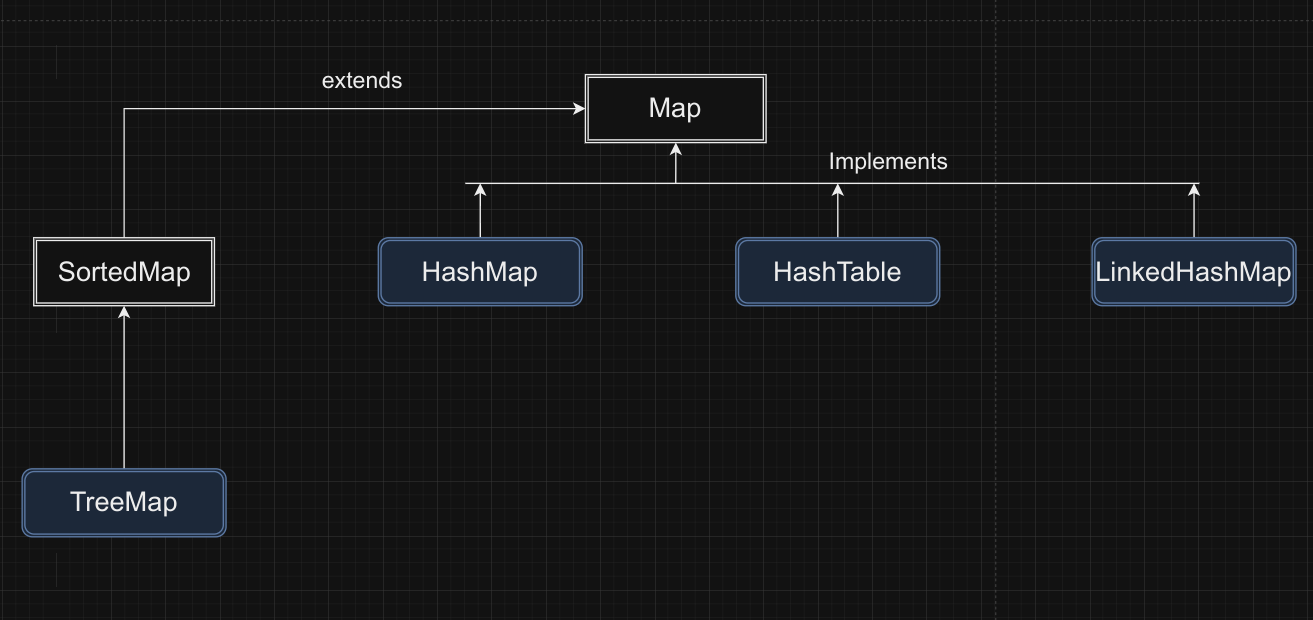21 Java - Map
 Chetan Datta
Chetan DattaTable of contents


Map
Its an interface and its implementations are
HashMap: Do not maintains the order.
HashTable: Synchronized version of HashMap
LinkedHashMap: Maintains the insertion order.
TreeMap: sorts the data internally.
Object that maps key to values.
Cannot contain duplicate key.
Methods available in Map interface
| Method | Usage |
size() | returns the number of key-value mapping present |
isEmpty() | true: if map contains no key-value mapping else false |
containsKey(Object key) | if given key is already present in the map returns true else false |
containsValue(Object value) | return true, if one or more key mapped to the specified value. |
get(Object key) | returns the value to which this key is mapped |
put(K key, V value) | if map already has the same key present: it will overwrite the value now provided. If map do not have the key present: it will add new key-value mapping. |
remove(Object key) | removes the key-value mapping from the map for the specified key. |
putAll(Map<K,V> m) | insert the mappings from the specified map to this map. |
clear() | removes all the mappings from the map |
Set<K> keySet() | returns the Set view of the Key contained in the Map. Set is backed by the Map, so changes in the Map, will be reflected in the Set and vice-versa. |
Collection<V> values() | returns the collection view of all the values. |
Set<Map.Entry<K,V>> entrySet() | returns the set view of the mappings present in the Map. |
putIfAbsent(K key, V value) | If key already exists return the value already associated, else create a new mapping with this key and value. |
getOrDefault(key, defaultValue) | if Key does not exist or value is null, it returns the default value. |
Entry sub-interface
Entry is the sub-interface of the Map. So, its accessed via Map.Entry
| Method | Usage |
getKey | return the Key |
getValue | returns the value |
int hashCode() | obtains the hashCode value |
boolean equals(Object o) | used to compare the 2 objects |
HashMap
Can store null key or value (HashTable do not contains null key or value)
Hash Map do not maintiains the insertion order.
Its not thread safe (instead use ConcurrentHashMap or HashTable for thread safe HashMap implementation)
Example
public class Main {
public static void main(String[] args) {
Map<Integer, String> rollNumberVsNameMap = new HashMap<>();
rollNumberVsNameMap.put(null, "TEST");
rollNumberVsNameMap.put(0,null);
rollNumberVsNameMap.put(1, "A");
rollNumberVsNameMap.put(2,"B");
//compute if present
rollNumberVsNameMap.putIfAbsent(null, "test");
rollNumberVsNameMap.putIfAbsent(0, "ZERO");
rollNumberVsNameMap.putIfAbsent(3, "C");
for (Map.Entry<Integer, String> entryMap : rollNumberVsNameMap.entrySet()){
Integer key = entryMap.getKey();
String value = entryMap.getValue();
System.out.println("Key: "+key+ " value: "+ value);
}
//isEmpty
System.out.println("isEmpty(): "+ rollNumberVsNameMap.isEmpty());
//size
System.out.println("size: " + rollNumberVsNameMap.size());
//containsKey
System.out.println("containsKey(3): "+ rollNumberVsNameMap.containsKey(3));
//get(key)
System.out.println("get(1): "+rollNumberVsNameMap.get(1));
//getOrDefault(key)
System.out.println("get(9): "+ rollNumberVsNameMap.getOrDefault(9, "default value"));
//remove(key)
System.out.println("remove(null): "+ rollNumberVsNameMap.remove(null));
//keySet()
for (Integer key: rollNumberVsNameMap.keySet()){
System.out.println("key: "+ key);
}
//values()
Collection<String> values = rollNumberVsNameMap.values();
for (String value: values){
System.out.println("value: "+value);
}
}
}
Key: null value: TEST
Key: 0 value: ZERO
Key: 1 value: A
Key: 2 value: B
Key: 3 value: C
isEmpty(): false
size: 5
containsKey(3): true
get(1): A
get(9): default value
remove(null): TEST
key: 0
key: 1
key: 2
key: 3
value: ZERO
value: A
value: B
value: C
Design of HashMap

Entry<K,V>
- Inside Map there is a sub interface called Entry<K,V>

- HashMap has Node<K,V> which implements Map.Entry<K,V>

- By default initial capacity of HashMap is 16 entries

Working
There are 3 main steps involved in using a HashMap:
Hashing: We compute the hash code for a particular key. There are many hashing algorithms like MD5 and SHA-256. We use these hash(key) functions to generate the hash code.
Indexing (Modulo): To get the index, we perform a modulo operation.
index=hash(key) % table_sizeCollision Handling: If an element is already present at index iii, the system checks whether the existing key and the supplied key are the same. If they are the same, the value is updated. If they are different, a new node is created next to the existing node at index iii. The existing node at index iii will then point to the newly created node, forming a linked list.
Let's assume that the initial capacity of the HashMap given by the user is 3.
put(1, "SJ")hash(1)=1234567
index=1234567%3=1(Assuming)
put(5, "PJ")hash(5)=982410
index=hash(5)%3=2 (Assuming)
put(10, "KJ")hash(10)=515100
index=515100%3=1 (Assuming)
Collision: If an element is already present at index 1, the system checks whether the existing key and the supplied key are the same. If they are the same, the value is updated. Otherwise, a new node is created next to the existing node at index 1. The existing node at index 1 will point to the newly created node.
When we perform put(1,"S"), put(2,"P"), and put(5,"K"), if the hash values modulo 3 are the same, they will map to the same index. In our case, if they all map to index 1, they will form a linked list at that index.

- get(5) will also generate the same hash code i.e hash(5) = 547383
Contract between hashcode and Equal
If object1 == object2 then their hash should also be same
If 2 objects hash is same then it doesn't mean that they are equal.
If we compute hash(5) as 547383, then no matter how many times we call the hash function for key 5, we get the same value, 547383.
Suppose hash(10) = 73333 and also hash(61) = 73333
If hash values are the same, it doesn't mean the objects are the same. In this case, the hash of 10 and 61 is 73333, but 10!=61.
Re-Hashing
How HashMap can offer O(1) for insertion, deletion, and seraching? (Rehashing)
If the hash function generates the same index then it will form a big linkedlist around that index.
Average Time Complexity - O(1)
Worst Time Complexity - O(n)
Load Factor
The load factor helps us achieve O(1) time complexity.
The load factor is 0.75. The default size of a HashMap is 16. This means that whenever the HashMap reaches 12 (0.75 * 16 = 12) key-value pairs, it will rehash. This means that it increases the size by doubling it, so from 16 it becomes 32. As soon as we insert the 13th element, it will rehash and increase the size of the HashMap. Additionally, it will recompute the hash values for all the key-value pairs and arrange them in new indices.
Treeify Threshold
What if we have sufficient space, but whatever we insert turns out to be a collision?
The default treeify threshold is 8, which means that whenever the linked list size is greater than 8, it converts the linked list into a tree. The tree is a balanced binary search tree, specifically a Red-Black Tree internally. Hence, the search time is O(logn) because the height of a balanced binary search tree is O(logn).

Time Complexity (Peformance)
Amortized meaning Average
Avg: O(1) - Insertion, Searching and Deletion
Worst Case: For Linked List - O(n), For Tree - O(logn)
LinkedHashMap

Helps in Maintain insertion order
(Or) Helps in Maintiain Access order.
Similar to HashMap, but also uses Double LinkedList.
Entry<K,V>
LinkedHashMap is exactly same as HashMap with extra addition after and before fields in Entry<K,V>

next: Stores the address of the node that falls under the same index or bin.
before: Stores the address of the previous node that was inserted into the map before the current value.
after: Stores the address of the next node that was inserted into the map after the current value.
Working
Lets consider example. We insert the following 6 values to LinkedHashMap.
map.put(1, "A");
map.put(21, "B");
map.put(23, "C");
map.put(141, "D");
map.put(25, "E");
next representation

before and after representation

Line Representations

after and before are used only for accessing the elements in the same order in which they were initially inserted into the LinkedHashMap.
public class Main {
public static void main(String[] args) {
System.out.println("------below is LinkedHashMap output ------------");
Map<Integer, String> map = new LinkedHashMap<>();
map.put(1, "A");
map.put(21, "B");
map.put(23, "C");
map.put(141, "D");
map.put(25, "E");
map.forEach((Integer key, String val) -> System.out.println(key+" : "+ val));
System.out.println("-------below is normal hash map output -----------");
Map<Integer, String> map2 = new HashMap<>();
map2.put(1, "A");
map2.put(21,"B");
map2.put(23, "C");
map2.put(141,"D");
map2.put(25,"E");
for (Map.Entry<Integer, String> entry : map2.entrySet()){
System.out.println(entry.getKey()+":"+entry.getValue());
}
}
}
------below is LinkedHashMap output ------------
1 : A
21 : B
23 : C
141 : D
25 : E
-------below is normal hash map output -----------
1:A
21:B
23:C
25:E
141:D
ACCESS ORDER = TRUE
So, when access order is set to true, the map is arranged such that the most frequently accessed elements are placed at the end.
This means that less frequently accessed elements will be at the beginning and the most frequently accessed ones will be at the end.
This is achieved directly putting the element to the last.

public class Main {
public static void main(String[] args) {
System.out.println("------below is LinkedHashMap output ------------");
Map<Integer, String> map = new LinkedHashMap<>(16, 0.75F, true);
map.put(1, "A");
map.put(21, "B");
map.put(23, "C");
map.put(141, "D");
map.put(25, "E");
//accessing some data
map.get(23);
map.get(23);
map.get(21);
map.forEach((Integer key, String val) -> System.out.println(key + ":"+ val));
}
}
/*
------below is LinkedHashMap output ------------
1:A
141:D
25:E
23:C
21:B
*/
- Time complexity is same as of HashMap: Average O(1)
Thread Safe Version
Its not thread safe and there is no thread safe version available for this.
So we have to explicitly make it this collection thread safe like this
synchronizedMap puts
synchronizedkeyword while doing all the operations on LinkedHashMap.
Map<Integer, String> map2 = Collections.synchronizedMap(new LinkedHashMap<>());
TreeMap

Map is Sorted according to its natural ordering of its Key or by Comparator provided during map creation.
Its based on Red-black tree (Self Balancing Binary Search Tree)
O(logn) time complexity of insert, remove, get operations.
public class Main {
public static void main(String[] args) {
Map<Integer, String> map1 = new TreeMap<>((Integer key1, Integer key2) -> key2-key1);
map1.put(21, "SJ");
map1.put(13, "KJ");
map1.put(5, "TJ");
//decreasing order
map1.forEach((Integer key, String value) -> System.out.println(key + " : "+ value));
System.out.println("----------------------");
Map<Integer, String> map2 = new TreeMap<>();
map2.put(21, "SJ");
map2.put(11, "PJ");
map2.put(13, "KJ");
map2.put(5, "TJ");
//increasing order
map2.forEach((Integer key, String value) -> System.out.println(key + ":"+value));
}
}
21 : SJ
13 : KJ
5 : TJ
----------------------
5:TJ
11:PJ
13:KJ
21:SJ
Representation
It is represented as tree.


Methods available in SORTEDMAP interface
| S.No | Method Name |
| 1 | SortedMap<K,V> headMap(K toKey) |
| 2 | SortedMap<K,V> tailMap(K fromKey) |
| 3 | K firstKey() |
| 4 | K lastKey() |
public class Main {
public static void main(String[] args) {
SortedMap<Integer, String> map2 = new TreeMap<>();
map2.put(21, "SJ");
map2.put(11, "PJ");
map2.put(13, "KJ");
map2.put(5, "TJ");
System.out.println(map2.headMap(13));
System.out.println(map2.tailMap(13));
System.out.println(map2.firstKey());
System.out.println(map2.lastKey());
}
}
{5=TJ, 11=PJ}
{13=KJ, 21=SJ}
5
21
Methods Available in NAVIGABLEMAP interface
(rarely used)



Subscribe to my newsletter
Read articles from Chetan Datta directly inside your inbox. Subscribe to the newsletter, and don't miss out.
Written by

Chetan Datta
Chetan Datta
I'm someone deeply engrossed in the world of software developement, and I find joy in sharing my thoughts and insights on various topics. You can explore my exclusive content here, where I meticulously document all things tech-related that spark my curiosity. Stay connected for my latest discoveries and observations.